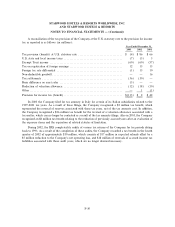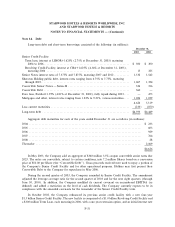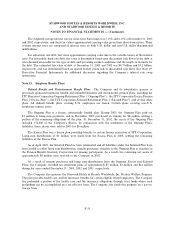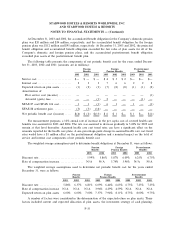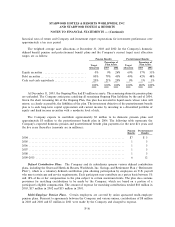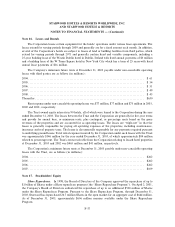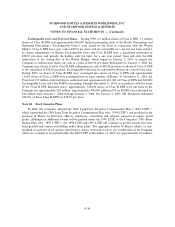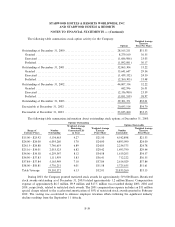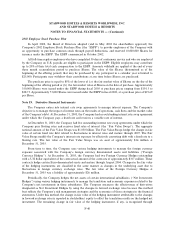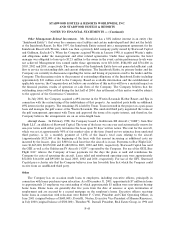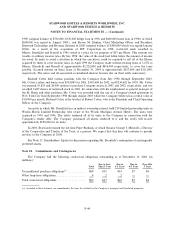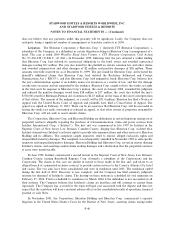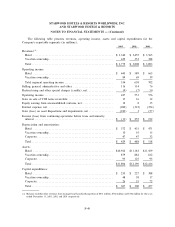Starwood 2003 Annual Report Download - page 106
Download and view the complete annual report
Please find page 106 of the 2003 Starwood annual report below. You can navigate through the pages in the report by either clicking on the pages listed below, or by using the keyword search tool below to find specific information within the annual report.STARWOOD HOTELS & RESORTS WORLDWIDE, INC.
AND STARWOOD HOTELS & RESORTS
NOTES TO FINANCIAL STATEMENTS Ì (Continued)
2002 Employee Stock Purchase Plan
In April 2002, the Board of Directors adopted (and in May 2002 the shareholders approved) the
Company's 2002 Employee Stock Purchase Plan (the ""ESPP'') to provide employees of the Company with
an opportunity to purchase common stock through payroll deductions, and reserved 10,000,000 Shares for
issuance under the ESPP. The ESPP commenced in October 2002.
All full-time regular employees who have completed 30 days of continuous service and who are employed
by the Company on U.S. payrolls are eligible to participate in the ESPP. Eligible employees may contribute
up to 20% of their total cash compensation to the ESPP. Amounts withheld are applied at the end of every
three month accumulation period to purchase Shares. The value of the Shares (determined as of the
beginning of the oÅering period) that may be purchased by any participant in a calendar year is limited to
$25,000. Participants may withdraw their contributions at any time before Shares are purchased.
The purchase price is equal to 85% of the lower of (a) the fair market value of Shares on the day of the
beginning of the oÅering period or (b) the fair market value of Shares on the date of purchase. Approximately
350,000 Shares were issued under the ESPP during Ñscal 2003 at purchase prices ranging from $19.13 to
$28.73. Approximately 73,000 Shares were issued under the ESPP in Ñscal 2002, at a purchase price of $19.69
per Share.
Note 19. Derivative Financial Instruments
The Company enters into interest rate swap agreements to manage interest expense. The Company's
objective is to manage the impact of interest rates on the results of operations, cash Öows and the market value
of the Company's debt. At December 31, 2003, the Company had no outstanding interest rate swap agreement
under which the Company pays a Ñxed rate and receives a variable rate of interest.
At December 31, 2003, the Company had Ñve outstanding interest rate swap agreements under which the
Company pays Öoating rates and receives Ñxed rates of interest (the ""Fair Value Swaps''). The aggregate
notional amount of the Fair Value Swaps was $1.050 billion. The Fair Value Swaps hedge the change in fair
value of certain Ñxed rate debt related to Öuctuations in interest rates and mature through 2007. The Fair
Value Swaps modify the Company's interest rate exposure by eÅectively converting debt with a Ñxed rate to a
Öoating rate. The fair value of the Fair Value Swaps was an asset of approximately $14 million at
December 31, 2003.
From time to time, the Company uses various hedging instruments to manage the foreign currency
exposure associated with the Company's foreign currency denominated assets and liabilities (""Foreign
Currency Hedges''). At December 31, 2003, the Company had two Foreign Currency Hedges outstanding
with a U.S dollar equivalent of the contractual amount of the contracts of approximately $317 million. These
contracts hedge certain Euro-denominated assets and mature through August 2004. Changes in the fair value
of the hedging instruments are classiÑed in the same manner as changes in the underlying asset due to
Öuctuations in foreign currency exchange rates. The fair value of the Foreign Currency Hedges at
December 31, 2003 was a liability of approximately $26 million.
Periodically, the Company hedges the net assets of certain international subsidiaries (""Net Investment
Hedges'') using various hedging instruments to manage the translation and economic exposures related to the
Company's net investments in these subsidiaries. The Company measures the eÅectiveness of derivatives
designated as Net Investment Hedges by using the changes in forward exchange rates because this method
best reÖects the Company's risk management strategies and the economics of those strategies in the Ñnancial
statements. Under this method, the change in fair value of the hedging instrument attributable to the changes
in forward exchange rates is reported in stockholders' equity to oÅset the translation results on the hedged net
investment. The remaining change in fair value of the hedging instrument, if any, is recognized through
F-40


